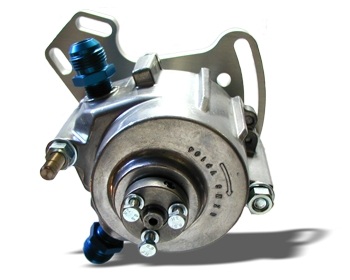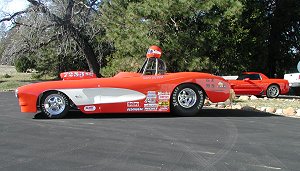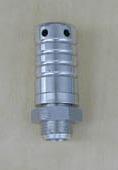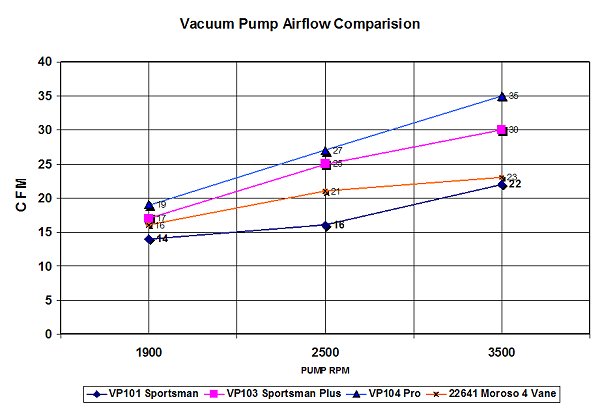The Pros and Cons of Racing Vacuum Pumps
...An in-depth Q & A with Greg Zucco, owner of GZ Motorsports
 Greg Zucco owner of GZ Motorsports
Greg Zucco owner of GZ Motorsports
Why do race cars run a vacuum pump?
Where it all began, at least in the NHRA Sportsman ranks, was with the introduction of mufflers to the racing class. Once the cars started running mufflers traditional pan evacuation systems (pan-evacs) no longer worked properly.
Racers started using vacuum pumps because air pressure in the pan started blowing oil out the gaskets and oil was leaking all over the place. That's when GZ Motorsports got involved.
Our first goal was to provide a pump to evacuate the pan and stop the leaks...the horsepower gains were simply a nice byproduct of that.
Why not use an OEM air pump?
Most OEM air pumps work great for a little while, but the factory units were not designed to be used in an oily environment. The general pump design is very sound they've proven themselves to be efficient and durable thanks to their heavy duty bearings and high airflow potential, they just need some modifications on the inside to make them compatible with oil. The Ford design pumps significantly out perform all other pumps, except the really high dollar aftermarket pumps. The only problem with an OEM pump direct from the factory is that the components inside were designed for oil-free air. In an oily environment they tended to lock up after only 15-35 runs because they have little carbon parts in them that are designed to be run dry. When oil gets in them it's like sandpaper and they last just a very short period of time ...and then they lock up.
The GZ Motorsports racing vacuum pump are based on a brand new redesigned OEM style air pump, but are modified for use in an oily environment using parts designed specifically for that purpose. Actually an OEM pump is a very reliable pump, designed for many years of use because there's thousands of hours in GM and Ford engineering in them. These pump designs do pump a lot of air, the trick is making their sealing system reliable, which GZ Motorsports has solved.
 GZMS New VP104 Super Pro Pump
GZMS New VP104 Super Pro Pump
For example, the IHRA Pro-Mod and some IHRA Pro Stock racers run a modified 3-vane Ford pump that outperforms any of the current aftermarket pumps. In most cases these types of pumps are primarily used by Sportsmen class and budget minded racers that want a pump that works, but don't want to pay an arm and a leg for it.
There's been a lot of discussion recently about OEM electrical air pumps, any comments on those?
Yeah - I tested a Corvette electrical pump about three years ago. In testing for pure vacuum, rather than airflow, they only made about 1.5" of mercury on a vacuum gauge. I also tested a Pontiac electrical pump that made about 3", which is about the same as what you would get out of a header pan-evac system. At best the electric pumps I've tested are about equivalent to a pan-evac system. I'm not current with the latest electric pumps because I abandoned that approach based on our testing. The Pontiac pump which has a lot larger motor than the Corvette pump would run the battery down very quickly if there was no alternator to keep the it charged. Again most of these pumps are designed for low air volume and an oil free environment, they might work adequately for a while, even as well as a similar to a pan-evac system, but they won't likely last a long time.
(Note - All references to vacuum measurements in this article are referring to inches of Mercury (inHg), a standard measurement for racing vacuum pumps)
If you decide to try one, make sure and install a vacuum gauge so you can measure how it's doing down track to see if it's keeping up with the blowby the motor is producing. If you want the real horsepower gains of a vacuum pump, you need to maintain around 15" of vacuum at high rpm, not just at idle.
What kind of typical Horsepower gains can you get with a vacuum pump?
Dean Nickerson of Nickerson Performance in Bristol Pennsylvania did a dyno test where he compared several vacuum pumps. He used the GZ Motorsports smaller Sportsman Pump which is actually a modified version of the Saginaw OEM style pump used by GM and Ford. The Sportsman pump was worth a 30hp gain on a 555ci BBC as compared to just breathers in the valve covers. He also reported better results with the GZ Motorsports pump over two other popular vacuum pumps.
When comparing the Sportsman pump to a functioning pan-evac system, the pump made an extra 17hp. That's with the Sportsman pump, and a very well sealed engine turning at about 75% engine speed. The combination netted approximately 20" of vacuum during the dyno pull. A properly designed pan-evac system with approximately 3" to 6" of vacuum at best, showed only minor horsepower gains.
Other people have reported the same results with dyno testing down in the Los Angeles area but I never could get results out of them in a "scientific format".
 New 57 Vette, one of the GZMS Research Cars
New 57 Vette, one of the GZMS Research Cars
What is the highest vacuum you should run?
Our opinion is around 15" with a wet sump oiling system, over that and I understand the oil mist is reduced to the point where you can lose lubrication to the wrist pins and cylinder walls. I think 15" is fine in a drag race application because the engine is at that RPM for such a short period of time. We highly recommend installing a vacuum relief valve that mounts to your valve cover and can be preset between 12" and 20" of vacuum.
How should you measure the vacuum in your crankcase?
We recommend a gauge on the dashboard connected to the valve cover, but on a Chevy you could also connect it to the fuel pump blockoff plate. We always hook them up to directly to the valve cover and that method works great. It's important to put the gauge in the car so you can see the readings downtrack at high RPM when the motor is pulling hard and blowby is at the maximum.
Where should you connect the vacuum pump pick up line?
Using traditional type fittings, you can just hook it up to a pan-evac type breather location or where your breathers are mounted. Most of the time that works fine, but sometimes it doesn't pick up enough oil and the pumps don't get lubricated sufficiently.
As an example, our pump is designed for an oil mist environment and will wear out prematurely if there isn't a small amount of oil getting to it. It needs to pick up enough oil to show up in the lines.
We sell fittings that can go in the top or on the front of the valve covers. Chevrolets usually get very little oil when the line is placed above the rocker because the stud girdles block a lot of the oil, for those motors it would be better to locate the bung at the front of the valve cover so the pump gets a little bit of oil.
If you're getting too much oil you can always put a little baffle in front of the bung to keep some of the oil from getting sucked in. Mopar heads, especially the B1 heads tend to have a lot of oil up in the valve covers for some reason. I've even seen as much as a pint of oil get sucked up during a single run, which is quite a bit of oil. To fix it, just baffle the valve cover pickup hole and then the problem is solved. Unfortunately, some people have the misguided notion that all they have to do is run a vacuum relief valve to fix the problem, that's just not true at all. It's a function of the amount of air that you're still sucking out of the motor. With a relief valve you're pulling the same amount of air out of the valve cover and approximately the same amount of oil which doesn't solve the problem. Baffles and/or line placement will have much greater effect on the amount of oil the pump removes from the motor.
Vacuum relief valves, how do they work?

A vacuum relief valve is basically just a controlled leak, it lets you set the amount of vacuum you want to run. When your motor reaches the pre-set level of vacuum, the valve opens and allows air into the motor. We highly recommend running one and setting it at approximately 15" of vacuum for a drag racing application. You really don't want to run over 15" in order to avoid potential problems with wrist pins.
What are the potential problems with running a vacuum pump?
Too much vacuum (more than 15" ), too little vacuum (less than 4"), and not running a vacuum gauge can all cause problems. There's no easy way to tell how much vacuum you're pulling on your motor without a gauge, which is why we highly recommend one. It's crazy not to run a gauge to know what vacuum you're pulling on the crankcase, especially at high rpm. Do you need to run low-tension oil rings with a vacuum pump?
Do you need to run low-tension oil rings with a vacuum pump?
You don't have to run low-tension oil rings, but if you do it helps your horsepower. Ring-wise, the more leakage you have the less vacuum you have, the more blow-by you have the less vacuum you have. It's even possible to overrun your pumps capacity to keep up due to excessive blowby.
For example alcohol applications seem to develop quite a bit more blowby than gasoline engines and thus the amount of vacuum you can get with a pump is reduced. In fact the richer you run your engine on alcohol the more blowby you'll get and the more vacuum you'll lose. My understanding is that on a good alcohol application you can lose a couple inches of vacuum over a gasoline engine, and the same thing is true of nitrous oxide applications. If you run a lot of nitrous you can create a lot of blowby, partially due to the wide end gaps many nitrous racers run.
I always run gapless rings in my own cars, and I know that if you do run a gapless ring package and low tension rings that vacuum pump really does help you. It's not necessary to run low tension rings with a vacuum pump, but you should see some horsepower benefits if you do.
Are there any issues with valve guide seals when running a vacuum pump?
We haven't run into any problems with running regular valve guide seals and I doubt anyone would unless they're trying to run a lot of vacuum. At 15" or less, the use of standard valve guide seals don't appear to be a problem.
Any need for kick-out style or other special oil pans?
We haven't seen a need for any special oil pans. There are likely some horsepower benefits from running them, but they aren't required when running a vacuum pump.
What do you need to do to build an engine for running a vacuum pump...do you need special seals?
Special seals aren't needed, standard seals like those from Fel-Pro work fine from what we have seen. You need to have your motor sealed well in order for the pump to work. One the worst vacuum leak sources is the oil dipstick - a leak there can cause severe vacuum leaks and it is often overlooked.
A Lokar o-ring style dipstick or a screw in type dipstick would work best. You can also use the stock type that has a little rubber seal in the cap. I can admit to wrapping a dipstick with electrical tape in order to seal it, in a pinch that will work, but it's not a good long-term solution.
How should you check for vacuum leaks?
We lightly pressurize the motor with air pressure and listen for leaks. You can also squirt some soapy water on the joints to look for places where it is leaking. Don't use a lot of air pressure, 1 psi of air or so is enough. If you use too much air pressure you'll deform the pan or valve covers, maybe even blow them off the motor.
What about special seals?
We just put everything together with silicone, I've always been a devote of goop. As long as you are careful that all your gaps and corners are siliconed you'll have a pretty tight motor. We don't recommend using those cheap gray, thin cardboard type gaskets, we suggest using something good like Fel-Pro gaskets, those work great for vacuum pump applications.
Does the rear main seal need to be turned around backwards for a vacuum pump system?
No, you don't need to do that with a good pump. On our own engines we don't do anything like that and can't see why someone would need to.
What kind of brackets does a person need in order to mount a vacuum pump, can you use OEM style brackets?
We have invented all the brackets and pulleys you need to mount the vacuum pump and alternator using a system of mounts that uses the water pump as the swing point for each unit. We also have brackets to use with electric water pumps and motor plates.
The only water pumps we have trouble with on our brackets is the polished Moroso electric water pump or Weiand electric pump that is similar to the Moroso, those need some grinding work for use with our bracket kits. None of our mounts are surface mount because our vacuum pumps need clearance for the fittings at the rear of the pump.
The crankshaft pulley we have developed is a fixed unit that sticks out about 4" from the dampner, this locates the alternator and pump about an inch in front of the heads. We manufacture great brackets that mount low or high, left side or right side.
Is there any preference on mounting locations, do they work better in any specific location?
Generally speaking it depends on your pump inlet and outlet locations, ideally you would like to have the inlet on the top and the outlet on the bottom.
What RPM should you run a vacuum pump at?
The GZ Motorsports pumps run at higher RPMs than most, we run our Sportsman pump between from 62% to 75% of engine speed, depending on the application. If you want to use a vacuum relief valve, we'll suggest running the pump at 75% of engine speed. If you don't want to run a relief valve, we suggest running it at 62% of engine speed for the Sportsman pump version. If a guy is running alcohol or high doses of Nitrous, we advise running it at 75% of engine speed due to the increase blow by in those applications.
With our new GZ Motorsports Pro pump we're running it at 62% of engine speed, because that pump can move about 70% more air over our Sportsman pump. The Pro pump can make 23" at 2500 rpm, where as our Sportsman pump makes the same at 3600 rpm.
Should you run your alternator and vacuum pump off the same belt?
On my own cars I use separate belts, just in case I lose a belt. It just makes sense to run one belt for each.
Any wrist pin lubrication problems or issues?
I've been told that wrist pins can be a problem in high vacuum situations, however we've never ran into a problem with wrist pins when using up to 15" of vacuum in our own motors.
I've ran my BBC 555 as high as 20" for a few runs without incident, but that amount can cause problems with oiling. I got nervous running that much vacuum and put the vacuum relief valve back on it. We ran that same motor at 15" for about four years with no problems, but that amount of vacuum should be considered the practical maximum. Typically people run around 10" to 12" with very good long term results. We believe that a practical maximum for a wet sump in a long term drag race application is around 15" due to the short duration of time that a drag race engine is at rpm on the track.
Can you run a vacuum pump on the street?
The only problem with street use is that the extra usage tends to wear the pumps out quicker than race only applications. We tell people that run them on the street to make sure that they have some oil running through the pump to get the best life. At low rpm's on the street you just don't have the same volume of air and oil running through the pump and that tends to wear the pumps out prematurely. We now have a street kit that recirculates oil through the pump to make it live a lot longer during low RPM operation.
How much oil should you see in the oil puke can after a run?
You shouldn't really see any to speak of if you're pulling from a valve cover breather location, maybe a thimble full of oil. As long as you're seeing some oil inside your vacuum line that is enough for the pump to be lubricated. It's common not to have any significant accumulation of oil in the puke tank. The oil mist tends to stay in the air and most of it just goes out of the breather.
If you're using a bung on the front of the valve cover you'll tend to see more. If you have more than a thimble full of oil every run you might think about installing some baffles to reduce the amount of oil that is getting sucked out.
How many horsepower does it take to run a vacuum pump?
Once a vacuum pump is broken in, they turn very freely. It's a function of how well sealed the engine is, more horsepower is required on a tightly sealed engine. It's similar to a shop vac, when you put your hand over the hose you can hear the motor load down as it draws a vacuum inside the line. With the GZ Motorsports Pro pump on a bench mount with a 3/4 horsepower electrical motor, I can stall the motor with anything more than 23" of vacuum. So you can figure it takes about one horsepower to run, more or less, but the net gain is way ahead of the very small horsepower amount of horsepower it takes to run one of our pumps.
Are there any diagnostic benefits to running a pump?
Yes.. actually there is, I'm glad you've asked that. I have a client that has a data acquisition system on their dragster, it's a NHRA Super Eliminator. They were losing vacuum down track, so I get the pump back and I test it and the pump is fine. It turned out he was losing ring seal downtrack and that was indicated as a loss of crankcase vacuum. So it's a great diagnostic tool from that perspective. As he was going downtrack he was seeing less crankcase vacuum as compared to earlier runs, and as it turns out that was indicating that his ring seal was going away. The blowby was increasing disproportionately to the amount of vacuum the pump was able to pull and it showed up as less vacuum on his vacuum gauge downtrack.
How much vacuum should you see at idle?
Everyone's setup is different depending on how tight the motor is sealed up, but with our Sportsman pump most racers seem to run around 3" to 4" at idle.
Here's a chart of the amount of air our pumps can move

How does running a vacuum pump affect oil pressure?
I don't personally believe that a vacuum pump affects oil pressure that much from a physics point of view, because if you have atmospheric pressure in your pan or more or less pressure, it's still the same throughout the motor. It's a balance regardless of how you look at it on both intake and outlet sides of the oil pump. Normally racers won't experience any issues with oil pressure fluctuations or changes when using a vacuum pump on a wet sump engine.
How many runs should your pumps go before rebuild?
When they need rebuilt, you'll see a drop in vacuum by about 4", that's a good indicator. How many runs it will last is entirely dependant on how much oil mist the pump gets during use. That is hard to predict, but you should figure at least 150-200 passes, significantly more if the pump has adequite oil mist going through it. For pumps that are operated at a lower rpm than a race car, such as street use, or other applications that would have extended low RPM periods, we now offer a street kit that recirculates oil through the pump greatly reducing the time for rebuilds.
Our pumps seem to like synthetic oil, we've had pumps come in for a rebuild that were used with synthetic oil that had 250 runs on them and they looked like brand new inside and didn't need rebuilt. Our pumps are rebuildable, but they're not simple to work on so we usually have our customers send them in. For $75.00 we rebuild and test them.
The way our pumps are designed, they don't need cleaning everytime you take the car out...they basically don't need any maintenance as long as they get a little bit of oil from the valve cover.
What else does GZ Motorsports manufacture besides vacuum pumps?
We have an extensive line of brackets, pulleys and complete ready to go kits for vacuum pumps and alternators. Also available is a complete line of breather oil (puke) tanks, vacuum hoses with fittings and vacuum relief valves.
In our electrical line we have 12 and 16 volt super-mini alternators that work with our mounting kits. We also sell IMI Hi-Torque Starters and AGM Hi-Tech Gel Cell Solid State batteries.
Any new projects in the works?
GZ Motorsports has just started to manufacture a line of crank mandrels and mandrel pulleys and new design vacuum control valves. We also have two new Pro Pumps for high volume applications. Both are 1" longer than our Sportsman pump but retain the same diameter. One has two vanes and the higher volume one has three vanes. The difference between the two vane Pro Pump and our three vane Pro Pump is very nominal, but the Pro pulls 70% more airflow than our Sportsman version. Both are ideal for alky and nitrous high volume vacuum needs. All of our pumps are better engineered than most aftermarket pumps, they can be ran faster which generates more vacuum, they have bigger bearings - they're designed to last.
How did you guys get started in this business?
Actually the real story is, back in 1985 I was going to put an alternator on my race car, and I bought an alternator and got frustrated trying to find a set of brackets that would work together with it. You just couldn't match all of the brackets and pulleys that were available together, so I said "I can do this!!" and I came up with an alternator bracket kit, and that's how GZ Motorsports got started.
GZ Motorsports
(209) 296-3793
22338 Shake Ridge Road
Volcano, CA 95689
www.gzmotorsports.com
